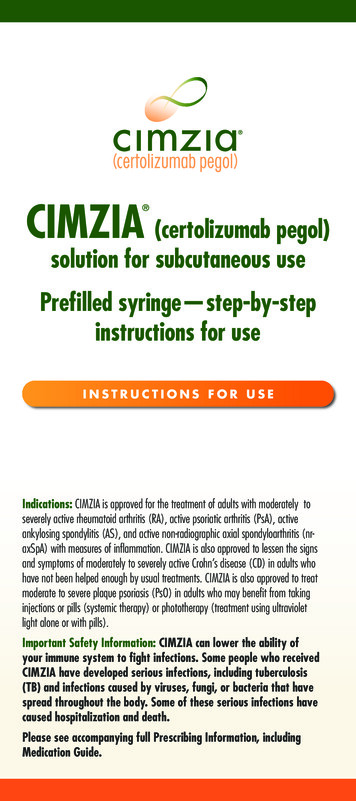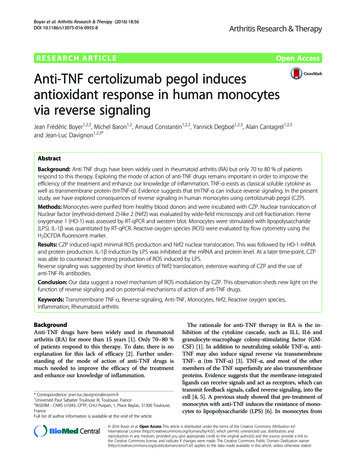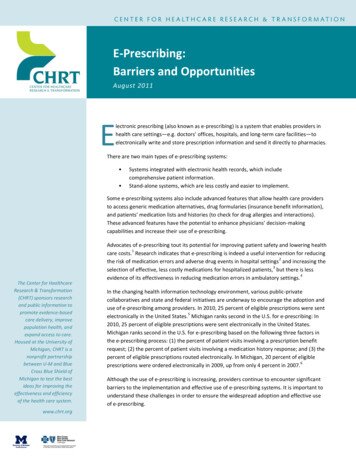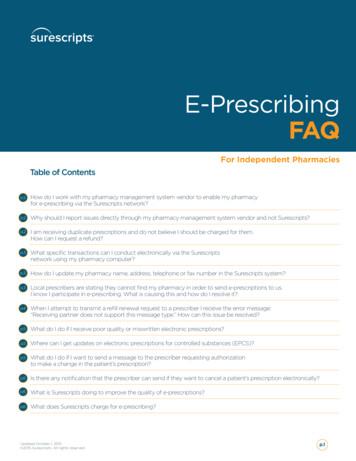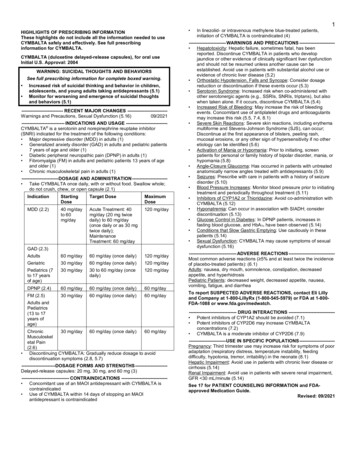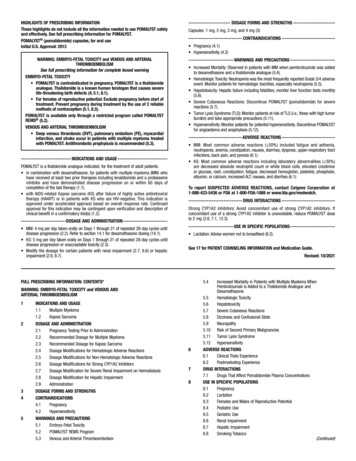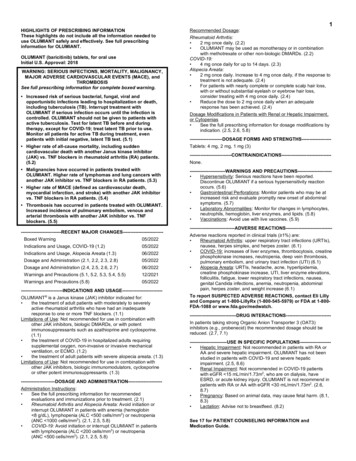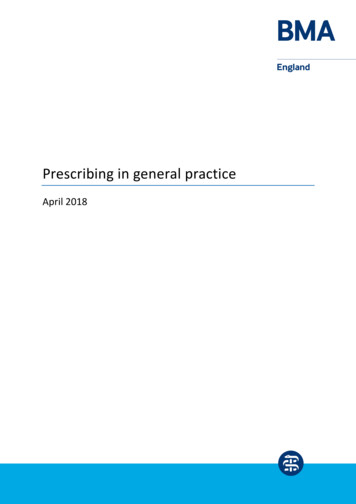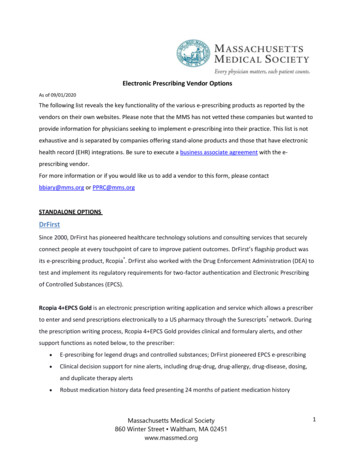
Transcription
HIGHLIGHTS OF PRESCRIBING INFORMATIONThese highlights do not include all the information needed to useCIMZIA safely and effectively. See full prescribing information forCIMZIA.----------------------DOSAGE FORMS AND STRENGTHS-------------------- For injection: 200 mg lyophilized powder in a single-dose vial (3) Injection: 200 mg/mL solution in a single-dose prefilled syringe (3)CIMZIA (certolizumab pegol) for injection, for subcutaneous useCIMZIA (certolizumab pegol) injection, for subcutaneous useInitial U.S. Approval: S------------------------------Serious hypersensitivity reaction to certolizumab pegol or to any of theexcipients. (4)------------------------WARNINGS AND PRECAUTIONS---------------------- Serious Infections: CIMZIA should not be initiated in patients with anactive infection. Monitor for infection during and after treatment;discontinue if a serious infection develops. If invasive fungal infectiondevelops in patients who reside or travel to regions where mycoses areendemic, consider empiric antifungal therapy. (5.1) Malignancies: Cases of lymphoma and other malignancies have beenobserved among patients receiving TNF blockers, including CIMZIA.(5.2) Heart Failure: Monitor patients for new onset or worsening congestiveheart failure. (5.3) Hypersensitivity Reactions: Discontinue CIMZIA and institute appropriatetherapy if anaphylaxis or other serious hypersensitivity reactions occur.(5.4) Hepatitis B Virus Reactivation: Test for HBV infection before startingCIMZIA. Monitor HBV carriers during and several months after therapy.If reactivation occurs, stop CIMZIA and begin anti-viral therapy (5.5) Neurologic Reactions: Exacerbation or new onset demyelinating diseasemay occur; use caution in patients with pre-existing or recent-onsetdemyelinating disorders. (5.6) Hematological Reactions (including leukopenia, pancytopenia andthrombocytopenia): Use with caution in patients who have ongoing, or ahistory of, significant hematologic abnormalities. Advise patients to seekimmediate medical attention if symptoms develop; consider discontinuingCIMZIA in patients with confirmed abnormalities. (5.7) Use with Anakinra, Abatacept, Rituximab and Natalizumab: Increasedrisk of serious infections; concomitant use is not recommended. (5.8, 7.1) Autoimmunity: Discontinue CIMZIA if lupus-like syndrome develops.(5.9) Live vaccines: Avoid use with CIMZIA (5.10, 7.2)WARNING: SERIOUS INFECTIONS AND MALIGNANCYSee full prescribing information for complete boxed warning.oooooIncreased risk of serious infections leading to hospitalization ordeath including tuberculosis (TB), bacterial sepsis, invasivefungal infections (such as histoplasmosis), and infections due toother opportunistic pathogens (5.1).CIMZIA should be discontinued if a patient develops a seriousinfection or sepsis (5.1).Perform test for latent TB; if positive, start treatment for TBprior to starting CIMZIA (5.1).Monitor all patients for active TB during treatment, even ifinitial latent TB test is negative (5.1)Lymphoma and other malignancies, some fatal, have beenreported in children and adolescent patients treated with TNFblockers, of which CIMZIA is a member (5.2). CIMZIA is notindicated for use in pediatric patients. (8.4)----------------------------RECENT MAJOR CHANGES-------------------------Indications and Usage (1.5)Dosage and Administration (2.5)Dosage and Administration (2.7)Warnings and Precautions -----------INDICATIONS AND USAGE--------------------------CIMZIA is a tumor necrosis factor (TNF) blocker indicated for: Reducing signs and symptoms of Crohn’s disease and maintaining clinicalresponse in adult patients with moderately to severely active disease whohave had an inadequate response to conventional therapy (1.1) Treatment of adults with moderately to severely active rheumatoidarthritis (1.2) Treatment of adult patients with active psoriatic arthritis. (1.3) Treatment of adults with active ankylosing spondylitis (1.4) Treatment of adults with active non-radiographic axial spondyloarthritiswith objective signs of inflammation (1.5) Treatment of adults with moderate-to-severe plaque psoriasis who arecandidates for systemic therapy or phototherapy (1.6)------------------------------ADVERSE REACTIONS-----------------------------Most common adverse reactions ( 7%): upper respiratory tract infection, rash,and urinary tract infection (6.1)To report SUSPECTED ADVERSE REACTIONS, contact UCB, Inc. at1-866-822-0068 or FDA at 1-800-FDA-1088 or -DRUG INTERACTIONS----------------------------- Laboratory Tests: May cause erroneously elevated aPTT results. (7.3)-----------------------DOSAGE AND ADMINISTRATION----------------------CIMZIA is administered by subcutaneous injection. The recommended initialdose of CIMZIA is 400 mg (given as two subcutaneous injections of 200 mg)(2).Crohn’s Disease (2.1) 400 mg initially and at Weeks 2 and 4. If response occurs, follow with400 mg every four weeksRheumatoid Arthritis (2.2) 400 mg initially and at Weeks 2 and 4, followed by 200 mg every otherweek; for maintenance dosing, 400 mg every 4 weeks can be consideredPsoriatic Arthritis (2.3) 400 mg initially and at week 2 and 4, followed by 200 mg every otherweek; for maintenance dosing, 400 mg every 4 weeks can be considered.Ankylosing Spondylitis (2.4) 400 mg (given as 2 subcutaneous injections of 200 mg each) initiallyand at weeks 2 and 4, followed by 200 mg every other week or 400 mgevery 4 weeks.Non-radiographic Axial Spondyloarthritis (2.5) 400 mg (given as 2 subcutaneous injections of 200 mg each) initiallyand at weeks 2 and 4, followed by 200 mg every other week or 400 mgevery 4 weeks.Plaque Psoriasis (2.6, 14.6) 400 mg (given as 2 subcutaneous injections of 200 mg each) every otherweek. For some patients (with body weight 90 kg), a dose of 400 mg(given as 2 subcutaneous injections of 200 mg each) initially and atWeeks 2 and 4, followed by 200 mg every other week may beconsidered.See 17 for PATIENT COUNSELING INFORMATION and MedicationGuide.Revised: 09/20191
FULL PRESCRIBING INFORMATION: CONTENTS*WARNING: SERIOUS INFECTIONS ANDMALIGNANCY1INDICATIONS AND USAGE1.1 Crohn’s Disease1.2 Rheumatoid Arthritis1.3 Psoriatic Arthritis1.4 Ankylosing Spondylitis1.5 Non-radiographic Axial Spondyloarthritis1.6 Plaque Psoriasis2DOSAGE AND ADMINISTRATION2.1 Crohn’s Disease2.2 Rheumatoid Arthritis2.3 Psoriatic Arthritis2.4 Ankylosing Spondylitis2.5 Non-radiographic Axial Spondyloarthritis2.6 Plaque Psoriasis2.7 Preparation and Administration of CIMZIA Usingthe Lyophilized Powder for Injection2.8 Preparation and Administration of CIMZIA Usingthe Prefilled Syringe2.9 Monitoring to Assess Safety2.10 Concomitant Medications3DOSAGE FORMS AND STRENGTHS4CONTRAINDICATIONS5WARNINGS AND PRECAUTIONS5.1 Risk of Serious Infections5.2 Malignancies5.3 Heart Failure5.4 Hypersensitivity Reactions5.5 Hepatitis B Virus Reactivation5.6 Neurologic Reactions5.7 Hematological Reactions5.8 Use with Biological Disease-ModifyingAntirheumatic Drugs (Biological DMARDs)5.9 Autoimmunity5.10 Immunizations5.11 ImmunosuppressionADVERSE REACTIONS6.1 Clinical Trials Experience6.2 Immunogenicity6.3 Postmarketing Experience7DRUG INTERACTIONS7.1 Use with Anakinra, Abatacept, Rituximab andNatalizumab7.2 Live Vaccines7.3 Laboratory Tests8USE IN SPECIFIC POPULATIONS8.1 Pregnancy8.2 Lactation8.4 Pediatric Use8.5 Geriatric Use10 OVERDOSAGE11 DESCRIPTION12 CLINICAL PHARMACOLOGY12.1 Mechanism of Action12.2 Pharmacodynamics12.3 Pharmacokinetics13 NONCLINICAL TOXICOLOGY13.1 Carcinogenesis, Mutagenesis, and Impairment ofFertility14 CLINICAL STUDIES14.1 Crohn’s Disease14.2 Rheumatoid Arthritis14.3 Psoriatic Arthritis14.4 Ankylosing Spondylitis14.5 Non-radiographic Axial Spondyloarthritis14.6 Plaque Psoriasis15 REFERENCES16 HOW SUPPLIED/STORAGE AND HANDLING17 PATIENT COUNSELING INFORMATION*Sections or subsections omitted from the full prescribinginformation are not listed.62
FULL PRESCRIBING INFORMATIONWARNING: SERIOUS INFECTIONS AND MALIGNANCYSERIOUS INFECTIONSPatients treated with CIMZIA are at increased risk for developing serious infections that may leadto hospitalization or death [see Warnings and Precautions (5.1) and Adverse Reactions (6.1)]. Mostpatients who developed these infections were taking concomitant immunosuppressants such asmethotrexate or corticosteroids.CIMZIA should be discontinued if a patient develops a serious infection or sepsis.Reported infections include: Active tuberculosis, including reactivation of latent tuberculosis. Patients with tuberculosishave frequently presented with disseminated or extrapulmonary disease. Patients should betested for latent tuberculosis before CIMZIA use and during therapy. Treatment for latentinfection should be initiated prior to CIMZIA use. Invasive fungal infections, including histoplasmosis, coccidioidomycosis, candidiasis,aspergillosis, blastomycosis, and pneumocystosis. Patients with histoplasmosis or other invasivefungal infections may present with disseminated, rather than localized disease. Antigen andantibody testing for histoplasmosis may be negative in some patients with active infection.Empiric anti-fungal therapy should be considered in patients at risk for invasive fungalinfections who develop severe systemic illness. Bacterial, viral and other infections due to opportunistic pathogens, including Legionella andListeria.The risks and benefits of treatment with CIMZIA should be carefully considered prior to initiatingtherapy in patients with chronic or recurrent infection.Patients should be closely monitored for the development of signs and symptoms of infection duringand after treatment with CIMZIA, including the possible development of tuberculosis in patientswho tested negative for latent tuberculosis infection prior to initiating therapy. [see Warnings andPrecautions (5.1) and Adverse Reactions (6.1)].MALIGNANCYLymphoma and other malignancies, some fatal, have been reported in children and adolescentpatients treated with TNF blockers, of which CIMZIA is a member [see Warnings and Precautions(5.2)]. CIMZIA is not indicated for use in pediatric patients.1INDICATIONS AND USAGECrohn’s DiseaseCIMZIA is indicated for reducing signs and symptoms of Crohn’s disease and maintaining clinicalresponse in adult patients with moderately to severely active disease who have had an inadequateresponse to conventional therapy.1.11.2Rheumatoid ArthritisCIMZIA is indicated for the treatment of adults with moderately to severely active rheumatoidarthritis (RA).3
1.3Psoriatic ArthritisCIMZIA is indicated for the treatment of adult patients with active psoriatic arthritis (PsA).1.4Ankylosing SpondylitisCIMZIA is indicated for the treatment of adults with active ankylosing spondylitis (AS). [seeClinical Studies (14.4)]1.5Non-radiographic Axial SpondyloarthritisCIMZIA is indicated for the treatment of adults with active non-radiographic axialspondyloarthritis (nr-axSpA) with objective signs of inflammation [see Clinical Studies (14.5)].1.6Plaque PsoriasisCIMZIA is indicated for the treatment of adults with moderate-to-severe plaque psoriasis (PsO)who are candidates for systemic therapy or phototherapy [see Clinical Studies (14.6)]2DOSAGE AND ADMINISTRATIONCIMZIA is administered by subcutaneous injection. Injection sites should be rotated and injectionsshould not be given into areas where the skin is tender, bruised, red or hard. When a 400 mg dose isneeded (given as two subcutaneous injections of 200 mg), injections should occur at separate sites in thethigh or abdomen.The solution should be carefully inspected visually for particulate matter and discoloration prior toadministration. The solution should be a clear colorless to yellow liquid, essentially free from particulatesand should not be used if cloudy or if foreign particulate matter is present. CIMZIA does not containpreservatives; therefore, unused portions of drug remaining in the syringe or vial should be discarded.Crohn’s DiseaseThe recommended initial adult dose of CIMZIA is 400 mg (given as two subcutaneous injectionsof 200 mg) initially, and at Weeks 2 and 4. In patients who obtain a clinical response, the recommendedmaintenance regimen is 400 mg every four weeks.2.12.2Rheumatoid ArthritisThe recommended dose of CIMZIA for adult patients with rheumatoid arthritis is 400 mg (givenas two subcutaneous injections of 200 mg) initially and at Weeks 2 and 4, followed by 200 mg every otherweek. For maintenance dosing, CIMZIA 400 mg every 4 weeks can be considered [see Clinical Studies(14.2)].2.3Psoriatic ArthritisThe recommended dose of CIMZIA for adult patients with psoriatic arthritis is 400 mg (given as2 subcutaneous injections of 200 mg each) initially and at week 2 and 4, followed by 200 mg every otherweek. For maintenance dosing, CIMZIA 400 mg every 4 weeks can be considered [see Clinical Studies(14.3)].2.4Ankylosing SpondylitisThe recommended dose of CIMZIA for adult patients with ankylosing spondylitis is 400 mg(given as 2 subcutaneous injections of 200 mg each) initially and at weeks 2 and 4, followed by 200 mgevery 2 weeks or 400 mg every 4 weeks.2.5Non-radiographic Axial SpondyloarthritisThe recommended dose of CIMZIA for adult patients with non-radiographic axialspondyloarthritis is 400 mg (given as 2 subcutaneous injections of 200 mg each) initially and at weeks 2and 4, followed by 200 mg every 2 weeks or 400 mg every 4 weeks.4
2.6Plaque PsoriasisThe recommended dose of CIMZIA for adults with moderate-to-severe plaque psoriasis is 400mg (given as 2 subcutaneous injections of 200 mg each) every other week.For some patients (with body weight 90 kg), CIMZIA 400 mg (given as 2 subcutaneousinjections of 200 mg each) initially and at Weeks 2 and 4, followed by 200 mg every other week can beconsidered [see Clinical Studies (14.6)].2.7Preparation and Administration of CIMZIA Using the Lyophilized Powder for InjectionCIMZIA Lyophilized powder should be prepared and administered by a health care professional.CIMZIA is provided in a package that contains everything required to reconstitute and inject the drug [seeHow Supplied/Storage and Handling (16)]. Step-by-step preparation and administration instructions areprovided below.Preparation and Storagea. If refrigerated, remove CIMZIA from the refrigerator and allow the vial(s) to sit at roomtemperature for 30 minutes before reconstituting. Do not warm the vial in any other way. Useappropriate aseptic technique when preparing and administering CIMZIA.b. Reconstitute the vial(s) of CIMZIA with 1 mL of Sterile Water for Injection, USP using the20-gauge needle provided. The sterile water for injection should be directed at the vial wallrather than directly on CIMZIA.c. Gently swirl each vial of CIMZIA for about one minute without shaking, assuring that all ofthe powder comes in contact with the Sterile Water for Injection. The swirling should be asgentle as possible in order to avoid creating a foaming effect.d. Continue swirling every 5 minutes as long as non-dissolved particles are observed. Fullreconstitution may take as long as 30 minutes. The final reconstituted solution contains 200mg/mL and should be clear to opalescent, colorless to pale yellow liquid essentially free fromparticulates.e. Once reconstituted, CIMZIA can be stored in the vials for up to 24 hours between 2 to 8 C(36 to 46 F) prior to injection. Do not freeze.Administrationa. Prior to injecting, reconstituted CIMZIA should be at room temperature but do not leavereconstituted CIMZIA at room temperature for more than two hours prior to administration.b. Withdraw the reconstituted solution into a separate syringe for each vial using a new 20-gaugeneedle for each vial so that each syringe contains 1 mL of CIMZIA (200 mg of certolizumabpegol).c. Replace the 20-gauge needle(s) on the syringes with a 23-gauge(s) for administration.d. Inject the full contents of the syringe(s) subcutaneously, by pinching the skin of the thigh orabdomen. Where a 400 mg dose is required, two injections are required, therefore, separatesites should be used for each 200 mg injection.2.8Preparation and Administration of CIMZIA Using the Prefilled SyringeAfter proper training in subcutaneous injection technique, a patient may self-inject with theCIMZIA Prefilled Syringe if a physician determines that it is appropriate. If refrigerated, remove the prefilled syringe from the carton and let it warm to room temperature.Inspect the liquid in the prefilled syringe. It should be clear and colorless to yellow and free fromparticulates. Discard the syringe if cloudy, discolored or contains particulates.Suitable sites for injection include the thigh or abdomen at least 2 inches away from the navel.5
Inject at least 1 inch from the previous site.Do not inject into areas where the skin is tender, bruised, red or hard, or where there are scars orstretch marks. The needle shield inside the removable cap of the CIMZIA prefilled syringe contains a derivativeof natural rubber latex which may cause allergic reactions and should be handled with caution by latexsensitive individuals [see Warnings and Precautions (5.4)].2.9Monitoring to Assess SafetyBefore initiation of therapy with CIMZIA, all patients must be evaluated for both active andinactive (latent) tuberculosis infection. The possibility of undetected latent tuberculosis should beconsidered in patients who have immigrated from or traveled to countries with a high prevalence oftuberculosis or had close contact with a person with active tuberculosis. Appropriate screening tests (e.g.tuberculin skin test and chest x-ray) should be performed in all patients.2.10Concomitant MedicationsCIMZIA may be used as monotherapy or concomitantly with non-biological disease modifyinganti-rheumatic drugs (DMARDs).The use of CIMZIA in combination with biological DMARDs or other tumor necrosis factor(TNF) blocker therapy is not recommended.3DOSAGE FORMS AND STRENGTHSFor Injection: 200 mg of white to off-white lyophilized powder in a single-dose vial for reconstitutionInjection: 200 mg/mL clear to opalescent, colorless to pale yellow solution in a single-dose prefilledsyringe4CONTRAINDICATIONSCIMZIA is contraindicated in patients with a history of hypersensitivity reaction to certolizumab pegol orto any of the excipients. Reactions have included angioedema, anaphylaxis, serum sickness, and urticaria[see Warnings and Precautions (5.4)].5WARNINGS AND PRECAUTIONS5.1Risk of Serious Infections[see Boxed Warning]Patients treated with CIMZIA are at an increased risk for developing serious infections involvingvarious organ systems and sites that may lead to hospitalization or death.Opportunistic infections due to bacterial, mycobacterial, invasive fungal, viral, parasitic, or otheropportunistic pathogens including aspergillosis, blastomycosis, candidiasis, coccidioidomycosis,histoplasmosis, legionellosis, listeriosis, pneumocystosis and tuberculosis have been reported with TNFblockers. Patients have frequently presented with disseminated rather than localized disease.Treatment with CIMZIA should not be initiated in patients with an active infection, includingclinically important localized infections. Patients greater than 65 years of age, patients with co-morbidconditions, and/or patients taking concomitant immunosuppressants (e.g. corticosteroids or methotrexate)may be at a greater risk of infection. The risks and benefits of treatment should be considered prior toinitiating therapy in patients: with chronic or recurrent infection6
who have been exposed to tuberculosis with a history of an opportunistic infection who have resided or traveled in areas of endemic tuberculosis or endemic mycoses, such ashistoplasmosis, coccidioidomycosis, or blastomycosis with underlying conditions that may predispose them to infectionTuberculosisCases of reactivation of tuberculosis or new tuberculosis infections have been observed in patientsreceiving CIMZIA, including patients who have previously or concomitantly received treatment for latentor active tuberculosis. Reports included cases of pulmonary and extrapulmonary (i.e., disseminated)tuberculosis. Evaluate patients for tuberculosis risk factors and test for latent infection prior to initiatingCIMZIA and periodically during therapy.Treatment of latent tuberculosis infection prior to therapy with TNF-blocking agents has beenshown to reduce the risk of tuberculosis reactivation during therapy. Prior to initiating CIMZIA, assess iftreatment for latent tuberculosis is needed; and consider an induration of 5 mm or greater a positivetuberculin skin test result, even for patients previously vaccinated with Bacille Calmette-Guerin (BCG).Consider anti-tuberculosis therapy prior to initiation of CIMZIA in patients with a past history oflatent or active tuberculosis in whom an adequate course of treatment cannot be confirmed, and forpatients with a negative test for latent tuberculosis but having risk factors for tuberculosis infection.Despite previous or concomitant treatment for latent tuberculosis, cases of active tuberculosis haveoccurred in patients treated with CIMZIA. Some patients who have been successfully treated for activetuberculosis have redeveloped tuberculosis while being treated with CIMZIA. Consultation with aphysician with expertise in the treatment of tuberculosis is recommended to aid in the decision of whetherinitiating anti-tuberculosis therapy is appropriate for an individual patient.Strongly consider tuberculosis in patients who develop a new infection during CIMZIA treatment,especially in patients who have previously or recently traveled to countries with a high prevalence oftuberculosis, or who have had close contact with a person with active tuberculosis.MonitoringPatients should be closely monitored for the development of signs and symptoms of infectionduring and after treatment with CIMZIA, including the development of tuberculosis in patients who testednegative for latent tuberculosis infection prior to initiating therapy. Tests for latent tuberculosis infectionmay also be falsely negative while on therapy with CIMZIA.CIMZIA should be discontinued if a patient develops a serious infection or sepsis. A patient whodevelops a new infection during treatment with CIMZIA should be closely monitored, undergo a promptand complete diagnostic workup appropriate for an immunocompromised patient, and appropriateantimicrobial therapy should be initiated.Invasive Fungal Infections7
For patients who reside or travel in regions where mycoses are endemic, invasive fungal infectionshould be suspected if they develop a serious systemic illness. Appropriate empiric antifungal therapyshould be considered while a diagnostic workup is being performed. Antigen and antibody testing forhistoplasmosis may be negative in some patients with active infection. When feasible, the decision toadminister empiric antifungal therapy in these patients should be made in consultation with a physicianwith expertise in the diagnosis and treatment of invasive fungal infections and should take into accountboth the risk for severe fungal infection and risks of antifungal therapy.5.2MalignanciesIn the controlled portions of clinical studies of some TNF blockers, more cases of malignancieshave been observed among patients receiving TNF blockers compared to control patients. Duringcontrolled and open-labeled portions of CIMZIA studies of Crohn’s disease and other diseases,malignancies (excluding non-melanoma skin cancer) were observed at a rate (95% confidence interval) of0.5 (0.4, 0.7) per 100 patient-years among 4,650 CIMZIA-treated patients versus a rate of 0.6 (0.1, 1.7)per 100 patient-years among 1,319 placebo-treated patients. During CIMZIA studies of psoriasis,malignancies (excluding non-melanoma skin cancer) were observed corresponding to an incidence rate of0.5 (0.2, 1.0) per 100 subject-years among a total of 995 subjects who received CIMZIA. The size of thecontrol group and limited duration of the controlled portions of the studies precludes the ability to drawfirm conclusions.Malignancies, some fatal, have been reported among children, adolescents, and young adults whoreceived treatment with TNF-blocking agents (initiation of therapy 18 years of age), of which CIMZIAis a member. Approximately half the cases were lymphomas, including Hodgkin’s and non-Hodgkin’slymphoma. The other cases represented a variety of different malignancies and included raremalignancies usually associated with immunosuppression and malignancies that are not usually observedin children and adolescents. The malignancies occurred after a median of 30 months of therapy (range 1to 84 months). Most of the patients were receiving concomitant immunosuppressants. These cases werereported post-marketing and are derived from a variety of sources including registries and spontaneouspost-marketing reports. CIMZIA is not indicated for use in pediatric patients.In the controlled portions of clinical trials of all the TNF blockers, more cases of lymphoma havebeen observed among patients receiving TNF blockers compared to control patients. In controlled studiesof CIMZIA for Crohn’s disease and other investigational uses, there was one case of lymphoma among2,657 Cimzia-treated patients and one case of Hodgkin’s lymphoma among 1,319 placebo-treatedpatients.In the CIMZIA RA clinical trials (placebo-controlled and open label) a total of three cases oflymphoma were observed among 2,367 patients. This is approximately 2-fold higher than expected in thegeneral population. Patients with RA, particularly those with highly active disease, are at a higher risk forthe development of lymphoma. In the CIMZIA PsO clinical trials (placebo-controlled and open label)there was one case of Hodgkin’s lymphoma.Rates in clinical studies for CIMZIA cannot be compared to the rates of clinical trials of other TNFblockers and may not predict the rates observed when CIMZIA is used in a broader patient population.Patients with Crohn’s disease that require chronic exposure to immunosuppressant therapies may be athigher risk than the general population for the development of lymphoma, even in the absence of TNFblocker therapy [see Adverse Reactions (6.1)]. The potential role of TNF blocker therapy in thedevelopment of malignancies in adults is not known.Postmarketing cases of hepatosplenic T-cell lymphoma (HSTCL), a rare type of T-cell lymphomathat has a very aggressive disease course and is usually fatal, have been reported in patients treated withTNF blockers, including CIMZIA. The majority of reported TNF blocker cases occurred in adolescentand young adult males with Crohn’s disease or ulcerative colitis. Almost all of these patients hadreceived treatment with the immunosuppressants azathioprine and/or 6-mercaptopurine (6-MP)concomitantly with a TNF blocker at or prior to diagnosis. It is uncertain whether the occurrence ofHSTCL is related to use of a TNF blocker or a TNF blocker in combination with these other8
immunosuppressants. The potential risk of using a TNF blocker in combination with azathioprine or 6MP should be carefully considered.Cases of acute and chronic leukemia have been reported in association with post-marketing TNFblocker use in RA and other indications. Even in the absence of TNF-blocker therapy, patients with RAmay be at a higher risk (approximately 2-fold) than the general population for the development ofleukemia.Melanoma and Merkel cell carcinoma have been reported in patients treated with TNF blockers,including CIMZIA. Periodic skin examinations are recommended for all patients, particularly those withrisk factors for skin cancer.5.3Heart FailureCases of worsening congestive heart failure (CHF) and new onset CHF have been reported withTNF blockers, including CIMZIA. CIMZIA has not been formally studied in patients with CHF;however, in clinical studies in patients with CHF with another TNF blocker, worsening congestive heartfailure (CHF) and increased mortality due to CHF were observed. Exercise caution in patients with heartfailure and monitor them carefully [see Adverse Reactions (6.1)].5.4Hypersensitivity ReactionsThe following symptoms that could be compatible with hypersensitivity reactions have beenreported rarely following CIMZIA administration to patients: angioedema, anaphylaxis, dyspnea,hypotension, rash, serum sickness, and urticaria. Some of these reactions occurred after the firstadministration of CIMZIA. If such reactions occur, discontinue further administration of CIMZIA andinstitute appropriate therapy. There are no data on the risks of using CIMZIA in patients who haveexperienced a severe hypersensitivity reaction towards another TNF blocker; in these patients caution isneeded [see Adverse Reactions (6.1)].The needle shield inside the removable cap of the CIMZIA prefilled syringe contains a derivativeof natural rubber latex which may cause an allergic reaction in individuals sensitive to latex.5.5Hepatitis B Virus ReactivationUse of TNF blockers, including CIMZIA, has been associated with reactivation of hepatitis B virus(HBV) in patients who are chronic carriers of this virus. In some instances, HBV reactivation occurringin conjunction with TNF blocker therapy has been fatal. The majority of reports have occurred in patientsconcomitantly receiving other medications that suppress the immune system, which may also contributeto HBV reactivation.Test patients for HBV infection before initiating treatment with CIMZIA. For patients who testpositive for HBV infection, consultation with a physician with expertise in the treatment of hepatitis B isrecommended. Adequate data are not available on the safety or efficacy of treating patients who arecarriers of HBV with anti-viral therapy in conjunction with TNF blocker therapy to prevent HBVreact
FULL PRESCRIBING INFORMATION: CONTENTS* WARNING: SERIOUS INFECTIONS AND MALIGNANCY 1 INDICATIONS AND USAGE 1.1 Crohn's Disease 1.2 Rheumatoid Arthritis 1.3 Psoriatic Arthritis 1.4 Ankylosing Spondylitis 1.5 Non-radiographic Axial Spondyloarthritis 1.6 Plaque Psoriasis 2 DOSAGE AND ADMINISTRATION 2.1 Crohn's Disease
